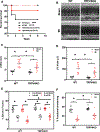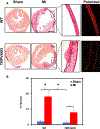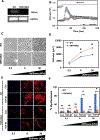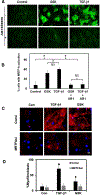TRPV4 deletion protects heart from myocardial infarction-induced adverse remodeling via modulation of cardiac fibroblast differentiation
- PMID: 31925567
- PMCID: PMC7322630
- DOI: 10.1007/s00395-020-0775-5
TRPV4 deletion protects heart from myocardial infarction-induced adverse remodeling via modulation of cardiac fibroblast differentiation
Abstract
Cardiac fibrosis caused by adverse cardiac remodeling following myocardial infarction can eventually lead to heart failure. Although the role of soluble factors such as TGF-β is well studied in cardiac fibrosis following myocardial injury, the physiological role of mechanotransduction is not fully understood. Here, we investigated the molecular mechanism and functional role of TRPV4 mechanotransduction in cardiac fibrosis. TRPV4KO mice, 8 weeks following myocardial infarction (MI), exhibited preserved cardiac function compared to WT mice. Histological analysis demonstrated reduced cardiac fibrosis in TRPV4KO mice. We found that WT CF exhibited hypotonicity-induced calcium influx and extracellular matrix (ECM)-stiffness-dependent differentiation in response to TGF-β1. In contrast, TRPV4KO CF did not display hypotonicity-induced calcium influx and failed to differentiate on high-stiffness ECM gels even in the presence of saturating amounts of TGF-β1. Mechanistically, TRPV4 mediated cardiac fibrotic gene promoter activity and fibroblast differentiation through the activation of the Rho/Rho kinase pathway and the mechanosensitive transcription factor MRTF-A. Our findings suggest that genetic deletion of TRPV4 channels protects heart from adverse cardiac remodeling following MI by modulating Rho/MRTF-A pathway-mediated cardiac fibroblast differentiation and cardiac fibrosis.
Keywords: Cardiac fibroblast; Cardiac fibrosis; Mechanotransduction; Myocardial infarction; Rho/Rho kinase; TGF-β1; TRPV4.
Conflict of interest statement
Figures






References
-
- Adapala RK, Thoppil RJ, Ghosh K, Cappelli HC, Dudley AC, Paruchuri S, Keshamouni V, Klagsbrun M, Meszaros JG, Chilian WM, Ingber DE, Thodeti CK (2016) Activation of mechanosensitive ion channel TRPV4 normalizes tumor vasculature and improves cancer therapy. Oncogene 35:314–322. 10.1038/onc.2015.83 - DOI - PMC - PubMed
Publication types
MeSH terms
Substances
Grants and funding
LinkOut - more resources
Full Text Sources
Medical
Molecular Biology Databases

